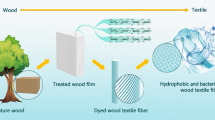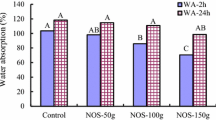Subject
The potential of improving the thickness swelling of commercial wood based panels by applying a new nanotechnology compound was investigated. The application of the compound SurfaPore™ W, an aqueous wood-water repellent resulted in a significant improvement in the thickness swelling of the panels tested.
Similar content being viewed by others
Avoid common mistakes on your manuscript.
1 Introduction
The main disadvantage of wood based panels, in their end use, is the dimensional stability or more precisely the dimensional instability. Therefore, improving and consequently decreasing their thickness swelling (TS) is one of the main issues. Many researchers have studied the dimensional stability of wood based panels as influenced by various processing variables, the most important being density, particle configuration and degree of bonding. An excellent review can be found in Kelly (1977). Briefly, there are several treatment methods which can be divided into three different means of application: pre-treatment, post-treatment and production technology. The first group includes methods that involve treatments applied to furnish before panel hot-pressing, such as particle pre-steaming and chemical or thermal modification of particles (Rowell et al. 1986; Youngquist et al. 1986; Wu 1999; Hill 2006; Paul et al. 2006). The second group comprises methods applied in the consolidated panels, and thermal treatment is the most common one (Del Menezzi and Tomaselli 2006; Okino et al. 2007). Last, the production technology methods involve those that are related to improving resin content, mat-forming type and application of water repellents (Halligan 1970; Wu 1999). Nowadays, the application of water-repellents is common practise. However, one of the major challenges in the manufacture of water-resistant wood based panels is to identify compatible combinations of water repellent chemicals and adhesives. Waxes are commercially used to improve the water repellency of wood based panels (Halligan 1970; Hsu et al. 1990). Oils, such as silixane systems and acrylic elastomeric coating systems, have been used to improve weather-proofing of siding panels (Hager and Mayer 1994; Jusoh et al. 2005). The use of silanes, silicones and siloxanes is well established for glass fiber reinforced plastic composites, but their use in wood based panels is rather limited mainly due to their water insolubility and tendency to form silica deposits (Jusoh et al. 2005).
An option to further reduce the TS of wood based panels in their end use, in combination with the treatments described above, is to exploit the solutions that nanotechnology can offer. Employing nanotechnology on wood and wood based panels can result in the next generation of products having hyper-performance and superior service ability when used in severe environments. It is well known that the cell wall of wood exhibits porosity of molecular scale dimensions due to the partial filling of space between the cellulose microfibrils by lignin, hemicelluloses and extractives (Wegner et al. 2005; Wegner and Jones 2006). The small size nanoparticles of such nanotechnology compounds can deeply penetrate into the wood, effectively alter its surface chemistry and result in a high protection against moisture. The aim of this research work therefore was to investigate the potential of improving TS of three commercial wood based panels by applying a new nanotechnology compound.
2 Experimental
A new nanotechnology compound, namely SurfaPore™ W, was supplied by the company NanoPhos SA and selected in order to investigate the potential of improving TS of commercial wood based panels. SurfaPore™ W is a water based formulation designed to harness the power of nanotechnology in order to preserve absorptive wooden surfaces. The formulation consists of three different nanoparticle sizes, specially designed to penetrate into the wood mass. The finest nanoparticles are intended to penetrate through the capillaries and bond with the hydroxyl groups of the cellulose content. The larger nanoparticles are intended to penetrate at the appropriate depth and react with the wood polymers. Finally, the formulation is completed by a nano-emulsion of paraffin that is intended to ensure surface protection. The physical and chemical properties of SurfaPore™ W are shown in Table 1.
Three wood based panels, namely particleboard, MDF and OSB were used in this work. Standard particleboard and MDF panels were randomly selected from the local market, while OSB specimens (grade OSB-3) were kindly supplied by the company Glunz Sonae Industria (Meppen, Germany). The density of the boards was 0.66, 0.70, and 0.63 gr/cm3 for particleboard, MDF and OSB, respectively, while the thickness was 18, 16, and 15 mm for particleboard, MDF and OSB, respectively.
The panels were cut into samples, each measuring 50 mm×50 mm×thickness. The surfaces of the samples were carefully sanded and cleaned. After conditioning at 20°C and 65% relative humidity for a week, the samples were immersed in a bath containing sufficient quantity of the compound for 30 sec at room temperature. The 30 sec immersion in the compound caused negligible swelling. Subsequently, excess of the chemical was wiped off, and the samples were re-conditioned as described above. The uptake of the SurfaPore™ W solution was 110, 135, and 155 g per square meter of the panel surface for OSB, particleboard, and MDF, respectively. The 24-hour TS after immersion in water was carried out according to the European Standard EN 317 (1993), both in treated and non-treated samples.
In addition, a t-test was conducted to assess the differences between treatments in the tests. The confidence level was defined at the 0.05 probability level. Prior to the t-test, the Anderson-Darling test was used to determine whether or not the variables follow a normal distribution (p<0.05).
3 Results and discussion
The thickness swelling values of the three commercial panels, namely particleboard, OSB and MDF, are summarised in Table 2. From this, it can be seen that the application of the nanotechnology compound SurfaPore™ W resulted in improved dimensional stability. Statistical analysis revealed that the improvement was significant at the 0.05 probability level for all panels tested. However, the magnitude of reduction in the TS was not the same for the three panels tested. Higher improvement was observed in MDF (13.6%), lower in OSB (9.9%), whereas an intermediate value was found in particleboard (12.1%). The higher improvement observed in MDF may be explained by bearing in mind that MDF is a solid and more homogeneous panel than particleboard and OSB. Therefore, it seems that the small size nanoparticles can penetrate into the panel more easily, resulting in higher protection against moisture. On the other hand, the higher pressure needed to consolidate the OSB mat results in an increased springback, which can partially explain the lower improvement in TS observed in this study.
A question that may arise from the methodology described above is the effect that immersion period may have on the dimensional stability. However, preliminary results clearly showed that prolonged period did not significantly affect the dimensional stability.
It was impossible to find comparable data in the literature on the use of similar compounds for improving the dimensional stability of wood based panels. From the data presented in this work, it is safe enough to conclude that nanotechnology compounds may be an option to reduce TS of wood based panels. SurfaPore™ W is an aqueous wood-water repellent and easy to apply, without changing the surface appearance. It does not contain any preservatives or other hazardous solvents and can be applied as a primer prior to application of varnish or any other coating, especially for exterior grade OSB.
Nevertheless, future work should focus on the investigation of the leachability of such compounds from wood based panels in moist conditions, the measurement of the penetration of the chemical into the panel and the “durability” of the nanotechnology treatments after accelerated weathering.
References
Del Menezzi CHS, Tomaselli J (2006) Contact thermal post-treatment of oriented strandboard to improve dimensional stability: a preliminary study. Holz- Roh Werkst 64:212–217
European Standard EN 317 (1993) Particleboards and fibreboards—determination of swelling in thickness after immersion in water. CEN European Committee for Standardisation
Hager R, Mayer H (1994) Waterborne silicones for wood protection. In: Paper presented at the 4th Asia pacific conference, May 1994
Halligan AF (1970) A review of the swelling in particleboard. Wood Sci Technol 4:301–312
Hill CAS (2006) Wood modification—chemical, thermal and other processes. Wiley, West Sussex
Hsu WE, Melanson RJ, Kozak PJ (1990) The effect of wax type and content on waferboard properties. In: 24th international particleboard composites symposium. Washington State University, Pullman, WA, pp 85–96
Jusoh EB, Nzokou B, Kamden P (2005) The effect of silicone on some properties of flakeboard. Holz- Roh Werkst 63:266–271
Kelly MW (1977) Critical literature review of relationships between processing parameters and physical properties of particleboard. USDA For Serv Gen Tech report FPL-10. Forest Products Laboratory, Madison, USA
Okino EYA, Teixeira DE, Del Menezzi CHS (2007) Post-thermal treatment of oriented strandboard made from cypress. Cienc Tecnolog 9:199–210
Paul W, Ohlmeyer M, Leithoff H, Boonstra MJ, Pizzi A (2006) Optimising the properties of OSB by a one-step heat pre-treatment process. Holz- Roh Werkst 64(3):227–234
Rowell RM, Wang RHS, Hyatt JA (1986) Flakeboards made from aspen and southern pine wood flakes reacted with gaseous ketene. J Wood Chem Tech 6(3):449–471
Wegner TH, Jones P (2006) Advancing cellulose-based nanotechnology. Cellulose 13:115–118
Wegner TH, Winandy JE, Ritter MA (2005) Nanotechnology opportunities in residential and non-residential construction. In: 2nd international symposium on nanotechnology in construction. Bilbao, Spain, pp 23–31
Wu O (1999) In-plane dimensional stability of oriented strand panel: effect of processing variables. Wood Fiber Sci 31(1):28–43
Youngquist AJ, Krzysik A, Rowell RM (1986) Dimensional stability of acetylated aspen flakeboard. Wood Fiber Sci 18(1):90–98
Acknowledgements
The authors wish to acknowledge Nanophos SA and Dr. Ioannis Arabatzis for their cooperation. In addition, the authors thank Dr. Thomas Schneider of the company Glunz Sonae Industria for kindly supplying the OSB specimens. The technical assistance of Mr. Ioannis Giannoulas of TEI Larissa is also acknowledged.
Author information
Authors and Affiliations
Corresponding author
Rights and permissions
About this article
Cite this article
Mantanis, G.I., Papadopoulos, A.N. Reducing the thickness swelling of wood based panels by applying a nanotechnology compound. Eur. J. Wood Prod. 68, 237–239 (2010). https://doi.org/10.1007/s00107-009-0401-6
Received:
Published:
Issue Date:
DOI: https://doi.org/10.1007/s00107-009-0401-6




